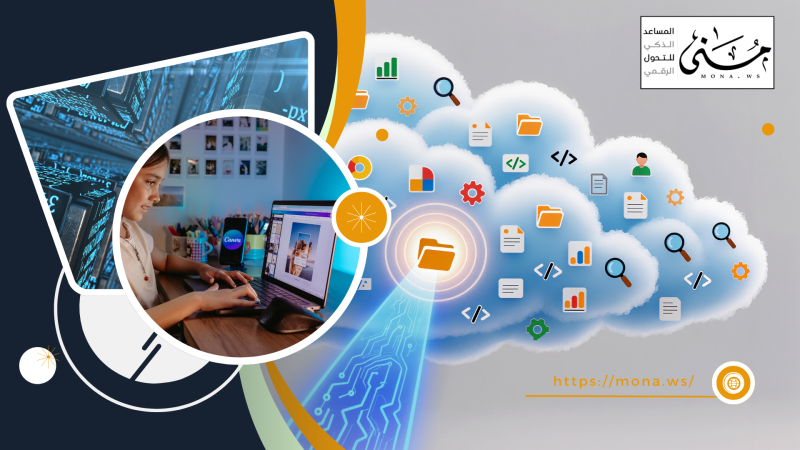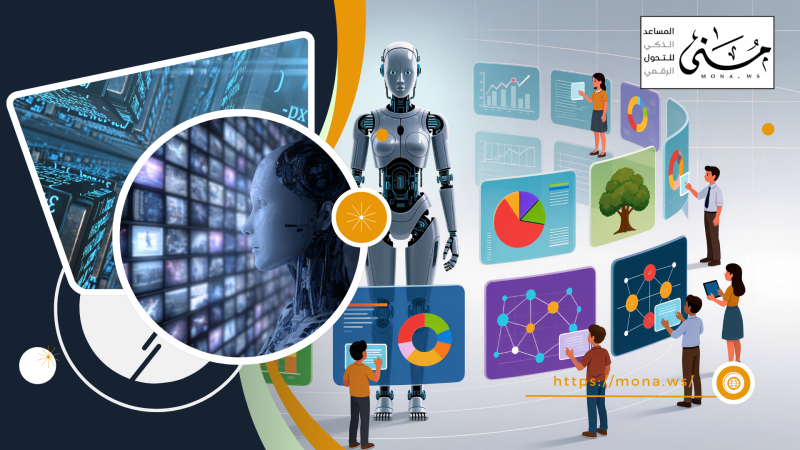With the rapid developments in business environments, organizations need the most advanced administrative communication systems to keep pace with digital transformations and achieve effective coordination between different departments.
In this article, we will learn more about the possibility of developing administrative communication to enhance organizational efficiency.
What is administrative communication?
Administrative communication is defined as the process through which information is exchanged within an organization between different administrative levels to ensure that organizational goals are achieved efficiently. Administrative communication includes the flow of instructions from senior management to employees, receiving feedback, and sharing data and reports necessary for decision-making.
Administrative communication is an essential element in the success of organizations, as it contributes to:
Organizing work and directing efforts: Ensures that all employees are clearly aware of the tasks assigned to them.
Promote transparency and interaction: Helps build a work environment based on trust and open communication.
Improve productivity: Reduces operational errors resulting from misunderstanding or lack of information.
Administrative communication takes many forms, such as:
Official Contact: It is communication that takes place through official channels within the organization, such as meetings, e-mail, and periodic reports.
informal communication: It occurs informally among employees and affects professional relationships and morale.
Up and down communicationUpward communication involves the transfer of information from employees to management, while downward communication involves the directives issued by management to employees.
What is the concept of organizational efficiency?
Organizational efficiency means the ability of an organization to achieve its goals with the best possible use of available resources, whether financial, human, or technological. Organizational efficiency depends on the extent to which the organization is able to improve its internal operations, utilize the skills of its employees, and develop effective strategies to ensure maximum productivity at the lowest possible costs.
Organizational efficiency includes several key aspects, including:
Resource management:Ensure that resources are optimally distributed to achieve maximum productivity.
Improving operational processesDevelop procedures and processes to be more flexible and efficient.
Make decisions based on dataRelying on accurate analysis of information to ensure effective strategic decisions.
Innovation and continuous development: Promote a culture of development within the organization to keep pace with changes in the work environment.
Administrative communication is one of the essential factors for enhancing organizational efficiency, as it contributes to facilitating the exchange of information, ensuring clarity of vision and goals, which leads to improving the overall performance of the organization and achieving better results in the work environment.
When a successful administrative communication system is implemented, management is able to accurately convey instructions, which raises the level of understanding between employees and enhances positive interaction within the work environment. This in turn contributes to increasing productivity and reducing operational errors, as employees can work according to a unified vision without conflicting tasks or goals.
|
Quality Management SystemISO 9001 is one of the most popular global systems for improving organizational efficiency, as it focuses on enhancing administrative communications and documenting processes to ensure the highest standards of quality and productivity. |
Important statistics about administrative communication and its impact on institutions
Recent studies indicate that organizations that rely on an effective administrative communication system achieve productivity rates that are up to 25% higher than those that suffer from weak internal communication channels, and 86% of employees believe that poor communication is the main reason for the failure of many projects within organizations.
On the other hand, research has shown that companies that apply digital communication technologies achieve a 30% faster response to changes, which enhances their ability to make informed strategic decisions. These figures confirm that developing administrative communication is no longer a luxury, but rather a necessity imposed by changing market requirements.
Features of modern administrative communication systems
Advanced administrative communication systems have several advantages that contribute to improving organizational performance and enhancing cooperation among employees, the most important of which are:
Promote effective communication
An effective administrative system facilitates the flow of information between different departments, allowing for real-time data exchange and reducing obstacles to operations.
Improve decision making speed
Effective administrative communication enables management to collect and analyze data faster, helping to make accurate, informed decisions, without the need for complex bureaucratic procedures.
Increase collaboration between teams
The administrative communication system contributes to providing a work environment that encourages teamwork by enhancing direct communication channels between different teams within the organization.
Reducing organizational conflicts
Misunderstandings within an organization often lead to conflicts that can negatively impact overall performance, therefore, a management communication system ensures clarity of roles and responsibilities, reducing the likelihood of disputes arising between employees.
Achieving regulatory transparency
Administrative communication helps spread a culture of transparency within the organization, as employees can easily access information, which enhances their level of trust and belonging.
|
Unified Communications System (Unified Communications (UC) is used in many global companies to integrate different means of communication, such as email, calls, and virtual meetings, which contributes to improving collaboration between teams and increasing response speed. |
The development of administrative communication systems in the digital age
Administrative communications have witnessed remarkable development over the past decade, as organizations have moved from using traditional methods to relying on artificial intelligence technologies and digital solutions to automate internal communication processes, including:
Digital CommunicationInstitutions have come to rely on advanced electronic platforms to manage administrative correspondence and archive documents, which contributes to organizing data and making it easy to retrieve when needed.
Virtual MeetingsWith the rise of remote work, virtual meetings have become an essential part of management communication, enabling teams to communicate seamlessly without the need to be physically present at the workplace.
Use of artificial intelligence: Artificial intelligence helps analyze administrative communications, extract important data, and provide recommendations that help improve performance and decision-making.
Administrative communications have become the cornerstone of building successful, efficient and sustainable organizations. By adopting modern communication systems based on digital technology, companies can achieve higher levels of productivity, innovation, and effective coordination between employees. Therefore, investing in developing administrative communication is no longer an option, but rather a necessity imposed by the requirements of the modern era.
The role of administrative communication in enhancing organizational efficiency
Administrative communication is one of the main pillars of achieving organizational efficiency within any organization, as it ensures that you:
- Improve the flow of information within the organization
Effective organizations rely on a smooth flow of information between different departments and management levels. When employees have access to the right information at the right time, they can perform their tasks more efficiently and make informed decisions based on accurate data.
|
Enterprise Resource Management System (ERM)ERP) contributes to improving coordination between different departments by integrating operational, financial and administrative processes into a single platform, which enhances the efficiency of communication and decision-making. |
- Enhancing coordination and integration between departments
Integration between departments is a crucial factor in improving organizational efficiency, as different work teams depend on each other to achieve the overall goals of the organization.
For example, when the purchasing department has immediate access to inventory data, it can make faster and more accurate decisions about supply orders, helping to reduce waste and improve operational efficiency.
- Support decision making process
Effective decision-making depends on the availability of accurate and up-to-date data, which is made possible by good administrative communication. Through modern communication systems, such as email, periodic reports, and digital platforms, managers can easily access information and analyze it in depth, which helps them make strategic decisions that improve the organization’s performance and enhance its sustainability..
- Increase transparency and trust within the workplace
Transparency is an important factor in improving organizational efficiency, as open administrative communication enhances trust between employees and management, motivates them to participate effectively in decision-making processes, and increases their loyalty to the organization.
- Improving crisis management and adapting to changes
Organizations are exposed to various challenges such as economic crises, technological changes, and shifts in market requirements. This is where effective administrative communication comes in to ensure a rapid response to these changes.
- Enhancing performance and productivity through motivation and guidance
Management communication is not only about conveying information, but also plays a major role in motivating employees and directing them towards achieving organizational goals.
- Leveraging Technology to Enhance Administrative Communication
With the rapid development of technology, organizations can adopt advanced digital solutions to improve administrative communication. Document management and electronic communications systems such as DocSuite provide a flexible and organized work environment, where organizations can automate administrative processes, manage internal communications effectively, which helps save time, reduce errors and improve workflow within the organization.
|
Doc Suite SystemDocSuite is one of the modern systems that bring about a digital transformation in the management of administrative communications, as it combines document management, organizing internal and external communications, and automating operations, which contributes to enhancing organizational efficiency, reducing operational errors, and improving the flow of information between different departments, using the latest technologies of artificial intelligence and cybersecurity. It is used in IT governance, where it helps improve communication between technical and administrative departments to ensure that the company's strategies are aligned with its technical goals. |
Administrative communication is a vital element in achieving organizational efficiency, as it helps improve the flow of information, enhance collaboration, support decision-making, increase transparency and trust, adapt to changes, and motivate employees. By adopting effective communication strategies and leveraging modern technology, organizations can achieve outstanding performance and achieve their goals more efficiently.
 الاتصال الإداري أحد العوامل الأساسية لتعزيز الكفاءة التنظيمية
الاتصال الإداري أحد العوامل الأساسية لتعزيز الكفاءة التنظيمية






Comments
Add New Comment